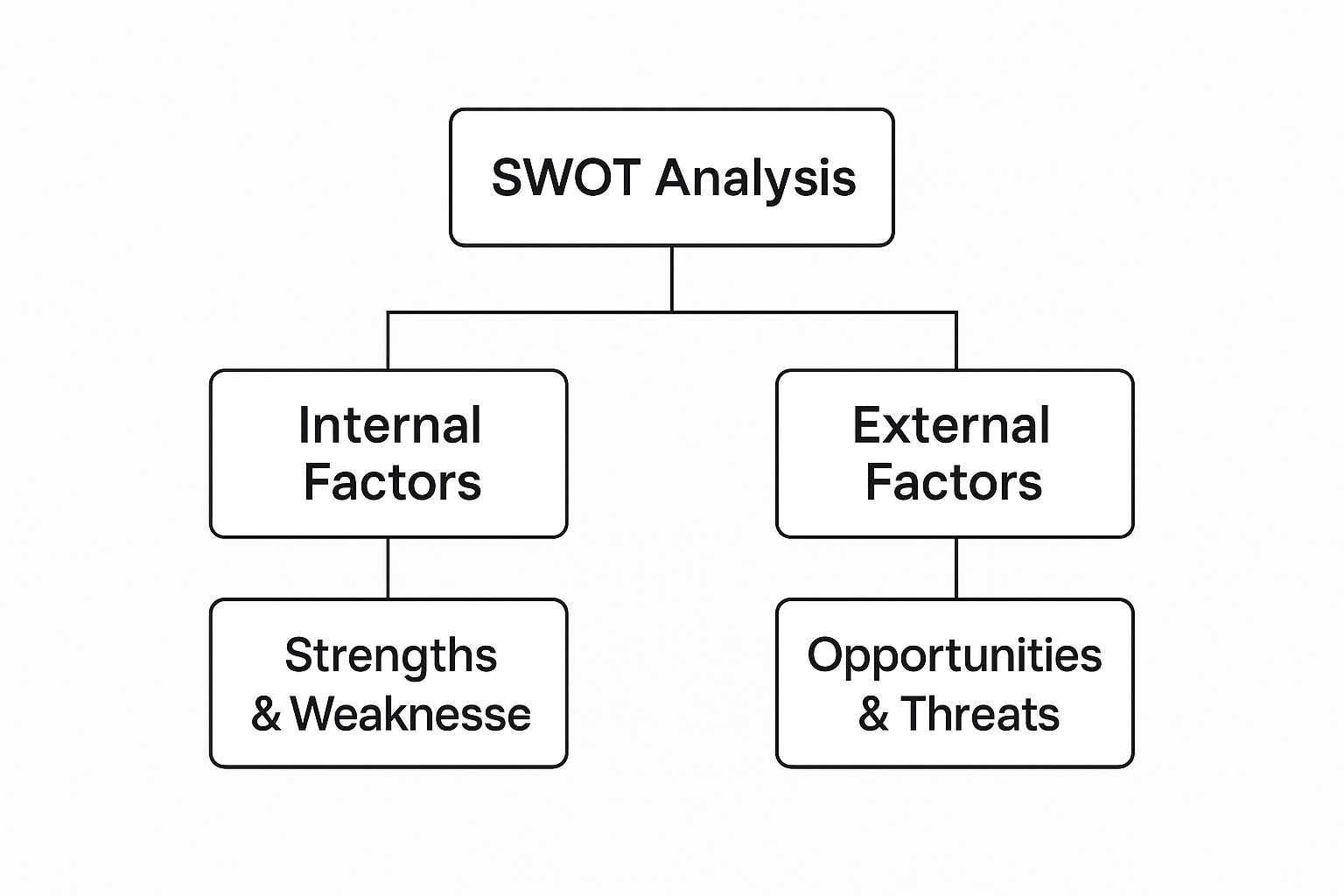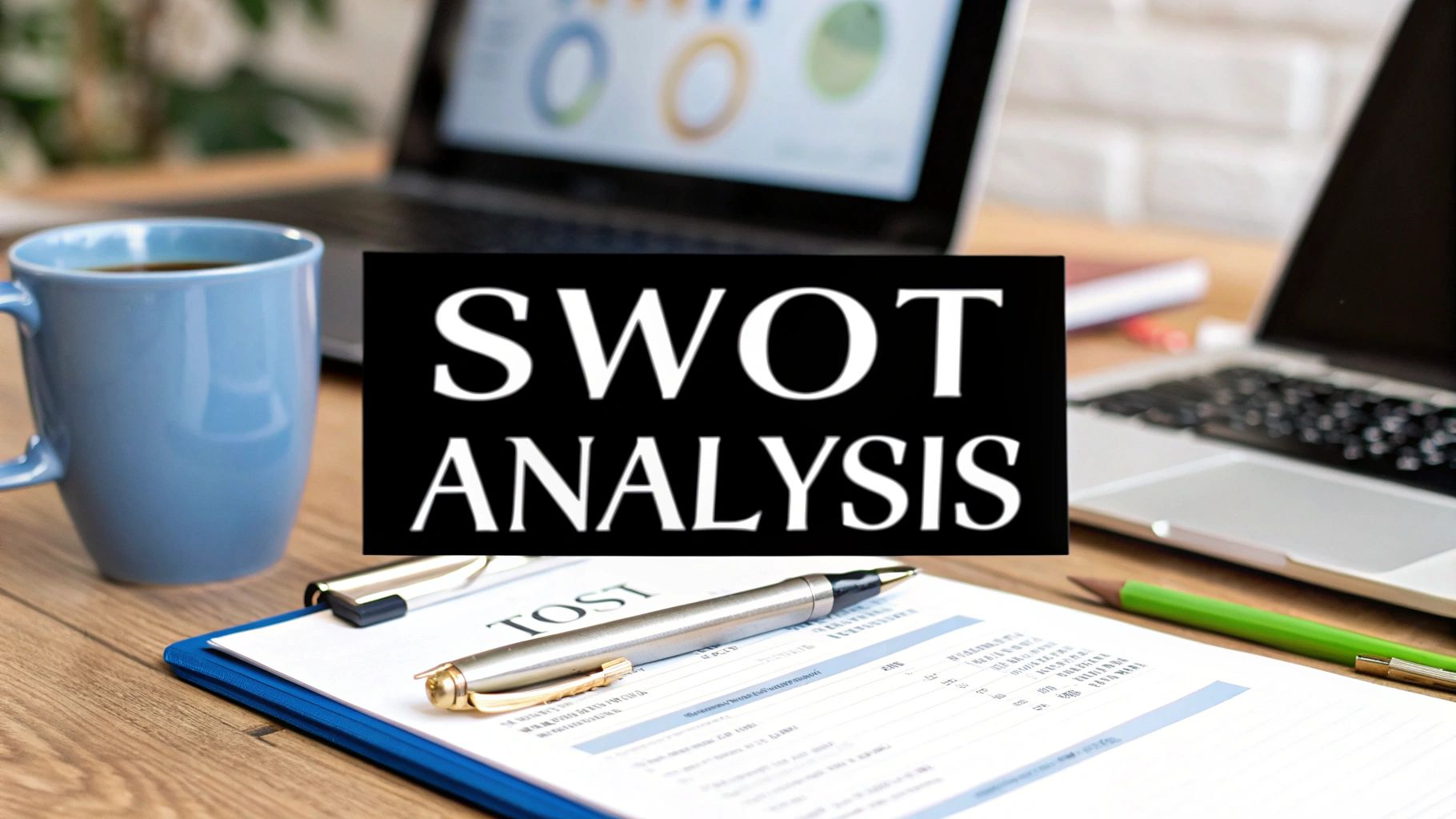A SWOT analysis is a brilliantly simple tool for getting an honest, clear-eyed look at your business. It stands for Strengths, Weaknesses, Opportunities, and Threats, and acts as a kind of strategic compass for a small business owner, helping you figure out exactly where you stand so you can build a smarter business plan.
Your Business Compass: What Is a SWOT Analysis?
If you're an entrepreneur, building a business plan can feel like trying to navigate a dense fog. The SWOT analysis is the tool that cuts through it. It’s a foundational exercise that gives you a realistic snapshot of your business right now, but more importantly, it helps you map out where you could go next as a small business.
This isn’t just about listing pros and cons. The framework forces you to look at your business model from four different angles, creating a truly balanced perspective. It makes a critical distinction between the things you can control and the outside forces you just have to react to.
- Internal Factors: These are the elements happening inside your company—your team’s unique skills, the reputation you’ve built, your operational efficiency. As a small business owner, you have a direct hand in shaping these.
- External Factors: These are the forces at play in the wider market—a new competitor, a sudden economic downturn, or a game-changing piece of technology. You can’t control them, but your business plan must be ready to respond.
The diagram below really clarifies how these factors fit together.

As you can see, it’s a simple grid that separates the good from the bad, and the internal from the external. It’s that simplicity that makes it so powerful for small entrepreneurs.
From Academic Tool to Business Staple
Though it’s a go-to for startups today, the SWOT analysis has been around for a while. It got its start back in the mid-1960s at the Stanford Research Institute. Back then, it was called SOFT analysis—Satisfactory, Opportunities, Faults, and Threats. 'Faults' eventually got a rebrand to the more constructive 'Weaknesses,' and the acronym we use today was born. Later, academics at Harvard Business School refined it into the internal/external framework that’s become a cornerstone of modern business planning.
A SWOT analysis isn’t just another box to check on your business plan. It’s about achieving clarity. It takes all those gut feelings you have about your small business and organizes them into concrete insights you can actually use in your marketing plan.
Once you have it all laid out, you can start connecting the dots. You might realize how a specific strength can help you jump on a new market opportunity. Or you might spot a glaring weakness that a competitor could exploit if you don’t address it in your business model.
This is the first step toward building a more durable business and a focused marketing strategy. If you're wondering how this applies to your specific situation, you can find more answers in our detailed FAQ section.
Breaking Down the Four Pillars of SWOT
So, what exactly is a SWOT analysis? Think of it less like a simple to-do list and more like a strategic map for your small business. It's built on a grid with four key areas, giving you a complete, panoramic view of where your business model stands.
The framework is split right down the middle into two distinct halves: the internal factors you have direct control over as a business owner, and the external factors you can only react to. Getting this distinction right is the first real step in turning this from a simple classroom exercise into a powerhouse tool for your business plan.
The diagram below lays out the elegant, yet critical, structure of a SWOT analysis. It clearly separates the internal world you shape from the external world you must navigate.

This visual split makes it obvious: your strengths and weaknesses are yours to own and manage, while opportunities and threats are market forces you need to anticipate and respond to in your marketing plan.
Internal Factors: What's Happening Inside Your Walls
These factors are the very DNA of your small business—the assets and liabilities that exist within your organization right now. You can directly influence, change, and improve them.
-
Strengths (S): These are your superpowers. They’re the positive attributes that give you a leg up on the competition. What do you do better than anyone else? That’s a strength.
-
Weaknesses (W): These are the internal hurdles holding you back. It’s tough, but being brutally honest about what’s not working is crucial for a solo entrepreneur. This is where you find the cracks in your foundation that need fixing to shore up your business and marketing plans.
To really get to the good stuff, ask tough questions. For Strengths, ask, "What unique asset does our brand own?" or "What are we famous for that our competitors can't claim?" For Weaknesses, try, "Where are the most significant gaps in our team's skills?" or "Which part of our customer's journey gets the most complaints?"
External Factors: The World Outside Your Control
Now we look outside. External factors are all the things happening beyond your company's front door. You can't control the weather, but you can decide to bring an umbrella. In the same way, you can’t stop a new competitor from opening up shop, but you can prepare your small business to respond strategically.
A common trap for entrepreneurs is mistaking internal goals for external realities. For example, listing "launching a new product" as an Opportunity is wrong. The real opportunity is the market demand for that product, which should inform your business model.
This is where you zoom out and look at the larger landscape your business operates in.
-
Opportunities (O): These are the favorable winds in the market that could give your business a serious boost. Think of them as open doors you can walk through to grow and claim a stronger market position.
-
Threats (T): These are the potential storms on the horizon that could cause real harm to your small business. Spotting threats early means you can build a contingency plan instead of just getting caught in the downpour.
To uncover Opportunities, ask, "What current market trends are we perfectly positioned to take advantage of?" or "Are there underserved customer groups we could target with our marketing plan?" For Threats, ponder, "What new technology could make our core product obsolete?" or "How would rising supplier costs squeeze our profit margins?"
To help organize these concepts, here’s a quick breakdown of the four quadrants and the kinds of questions that get the ball rolling for a new small business.
SWOT Analysis Quadrant Breakdown
| Component | Focus | Description | Example Question for an Entrepreneur |
|---|---|---|---|
| Strengths | Internal | Positive attributes and resources within the business that give it a competitive advantage. | What unique skills or experience does our founding team possess? |
| Weaknesses | Internal | Negative factors or areas where the business is lacking, creating a disadvantage. | Where are we most constrained by our limited budget or lack of brand recognition? |
| Opportunities | External | Favorable market trends, events, or conditions that the business can exploit for growth. | Is there a new social media platform where our target audience is gathering? |
| Threats | External | Unfavorable external factors that could negatively impact the business's success. | Are there any upcoming government regulations that could increase our costs? |
By clearly defining these four pillars, you're not just filling out a chart; you're building the foundation for a business plan that is both ambitious and firmly grounded in reality.
Why Every Small Business Needs a SWOT Analysis
As a small business owner, you know that every decision you make has real consequences. In an environment where resources are tight and the stakes are high, a SWOT analysis isn't just another piece of business jargon—it's one of the most practical tools you can have. Think of it as a diagnostic check-up for your company.
It gives you a clear, honest look at your business model and marketing plan, lighting up the path forward.

This simple four-quadrant framework helps you find competitive advantages you might have missed and spot operational weaknesses that could be holding you back. More importantly, by spotting potential threats on the horizon, you can prepare for them instead of being caught off guard. This kind of foresight is essential for any small business, especially when you're focused on building a recession-proof business.
From Insight to Action
Let's be honest, it's easy for small entrepreneurs to get so caught up in the daily grind that they don't have time to step back and think strategically. A SWOT analysis carves out that space. It forces you to ask the tough questions and evaluate your performance with brutal honesty.
But its real value is in turning those discoveries into a concrete game plan for your business.
- Sharpened Focus: You can pinpoint what truly makes your small business special and pour your marketing plan's efforts into highlighting those strengths.
- Strategic Improvement: It shines a light on your weaknesses, giving you a clear agenda for what processes, skills, or resources need shoring up within your business model.
- Proactive Growth: By identifying genuine market opportunities, you can develop strategies to get there before your competitors even see them coming.
Ultimately, this process ensures you're putting your limited time, money, and energy where they'll make the biggest difference.
The greatest value of a SWOT analysis is that it turns abstract goals into a tangible roadmap. It connects your internal reality to the external landscape, ensuring your business and marketing plans are grounded in strategy, not guesswork.
A Universally Trusted Framework
There's a reason the SWOT analysis is so widely used by entrepreneurs and established companies alike—it just works. It’s not some trendy tool for startups. In fact, surveys show that over 90% of medium and large companies regularly use it for strategic planning.
One global study even found that businesses combining a SWOT analysis with hard data saw a 15-25% jump in the success rate of their strategic projects. That's a serious return for what is often a simple, low-cost exercise that any small business can perform.
At the end of the day, taking the time to do a proper SWOT analysis leads directly to a smarter business plan, a more effective marketing plan, and a healthier bottom line for your small business.
How to Conduct Your First SWOT Analysis
Diving into a SWOT analysis isn't about finding some perfect, hidden answer. It's really about turning your abstract business ideas into a concrete strategic framework for your business plan. The whole point is to ask the right questions and answer them honestly.
The first move is always preparation. Before you even sketch out the four boxes, you need to ground your thinking in reality. That means gathering some objective data. For a small business, this could mean leveraging comprehensive business intelligence tools or simply getting the hard numbers you need from your own operations. Pull together customer feedback, look at your sales figures, and even check out what your competitors are up to online.
With that data in hand, it's time to brainstorm. Get your team in a room—or if you're a solo entrepreneur, grab a mentor you trust. The goal is to get as many ideas as possible for each of the four quadrants. Don't filter anything yet; just get it all out on the table.
Brainstorming with Purpose
To keep your brainstorming session from wandering off course, use some targeted questions to steer the conversation. This keeps the focus squarely on what's real for your small business.
- For Strengths: What do our customers always rave about? What do we have—a unique skill, a special asset—that nobody else can copy?
- For Weaknesses: Where do we tend to lose people in our sales funnel? What are the most common complaints we hear?
- For Opportunities: What market trends are lining up perfectly for our business model? Is there a group of potential customers that everyone else is ignoring?
- For Threats: Could a new piece of technology completely upend our business? How stable are our most important suppliers?
This kind of initial analysis is a cornerstone of any serious business plan. To see how this groundwork plugs into a bigger picture, check out our guide on how to conduct a feasibility study.
From Analysis to Action with the TOWS Matrix
Okay, so you've filled out your SWOT grid. Now what? A list of observations is great, but it's not a strategy. The real magic happens when you connect those insights to create an action plan for your small business. The best tool for this is the TOWS Matrix.
The TOWS Matrix is a brilliantly simple technique that forces you to pair your internal factors (Strengths, Weaknesses) with the external ones (Opportunities, Threats). This 2×2 grid approach really took off back in 1982, when Heinz Weihrich's work turned the SWOT analysis from a simple list into a powerful decision-making tool. His innovation helped make it a staple in strategic business planning—so much so that today, an estimated 70-80% of Fortune 500 companies rely on similar frameworks.
The TOWS Matrix challenges you to build specific strategies for your business and marketing plans by matching up the quadrants:
- Strengths-Opportunities (Maxi-Maxi): How do we use our strengths to go after these opportunities?
- Weaknesses-Opportunities (Mini-Maxi): How can we use these opportunities to fix our weaknesses?
- Strengths-Threats (Maxi-Mini): How can our strengths help us defend against these threats?
- Weaknesses-Threats (Mini-Mini): How do we minimize our weaknesses to avoid getting hit by these threats?
This structured process is what transforms your SWOT analysis from a static document into a dynamic roadmap. It gives you clear, strategic actions to propel your small business forward.
Real-World SWOT Analysis Examples for Small Businesses
Theory is great, but seeing a SWOT analysis in action is where the lightbulb really goes on. For small business owners, this isn't just a business school exercise; it's a practical way to build a smarter business plan. Let's walk through a couple of relatable examples to see how this framework turns abstract ideas into tangible strategies.

We'll look at a classic main-street shop—a local bakery—and then pivot to a modern digital venture run by a solo entrepreneur. This will show you just how flexible the SWOT framework really is for different business models.
Example 1: The Neighborhood Bakery
Let’s picture a small, independent bakery famous for its killer sourdough bread. The owner knows things are changing in town and wants to refresh their business plan.
-
Strengths: That sourdough recipe is one-of-a-kind and very hard to copy. They have a die-hard local following, and the head baker brings over 20 years of experience to the table. These are solid internal advantages for their business model.
-
Weaknesses: Their marketing budget is tiny, so they're stuck relying on word-of-mouth. Plus, the shop itself is small, which puts a cap on how many people can sit down and how much they can sell during a rush.
-
Opportunities: A "shop local, eat artisanal" movement is picking up steam in the community. On top of that, the town’s weekend farmers' market is looking for new vendors, which could open up a whole new sales channel.
-
Threats: The price of high-quality flour and other core ingredients keeps creeping up, eating into their profit margins. To make things worse, a big coffee chain with cheap pastries is opening just two blocks away.
The magic happens when you connect these dots for a marketing plan. The owner can use their Strength (the unique recipe) to jump on an Opportunity (the artisanal food trend) by launching a new line of premium, higher-priced loaves. This move could help offset the Threat of rising ingredient costs.
Example 2: The E-commerce Jewelry Store
Now, let's switch gears to an online store selling handmade, sustainable jewelry. The founder is a solo entrepreneur trying to figure out how to scale up her marketing plan.
A classic trap for e-commerce entrepreneurs is putting all their eggs in one marketing basket. A quick SWOT analysis often shines a harsh light on this, pushing them to diversify their marketing plan before an algorithm change tanks their business.
Here’s what her SWOT analysis might reveal:
-
Strengths: The jewelry has a distinctive design style that’s instantly recognizable. Her brand story, built around sustainability, really connects with her ideal customers.
-
Weaknesses: A staggering 90% of her sales come directly from Instagram. That's a huge risk for her business model. As a solo operator, her ability to produce more jewelry is also severely limited.
-
Opportunities: More and more consumers are actively searching for sustainable and ethically made products. She could also partner with eco-conscious bloggers and influencers to get her brand in front of new audiences.
-
Threats: Social media is a moving target; a simple algorithm update on Instagram could make her business virtually invisible overnight. Big fast-fashion brands are also starting to launch their own "eco-friendly" lines at rock-bottom prices.
The strategy writes itself. The owner can play to her Strength (powerful brand story) by chasing an Opportunity (influencer partnerships) to build traffic sources beyond Instagram. This directly tackles the Threat of algorithm changes and shores up the Weakness of relying on a single platform in her marketing plan.
These examples show how a SWOT analysis evolves from a simple list into a powerful strategic guide for a small business. For more ideas, check out this detailed business plan example for a coffee shop, which applies similar thinking to map out a complete strategy.
Common Mistakes to Avoid in Your SWOT Analysis
A SWOT analysis can be a game-changer for your business plan, but only if you do it right. It's surprisingly easy for small entrepreneurs to fall into a few common traps that turn this powerful strategic tool into a simple box-ticking exercise with no real impact.
One of the biggest culprits? Being way too generic.
Saying you have "good customer service" is nice, but it's not a measurable strength. What does that even mean? A much stronger, more actionable insight would be pointing to your "95% positive customer reviews" or an "average support ticket response time of under 30 minutes." See the difference? Specifics give your analysis teeth and make your business plan more credible.
Another classic mistake is mixing up what's happening inside your company with what's happening outside in the market. I've seen entrepreneurs list "launching a new product" as an opportunity. But launching a product is a decision you make—it’s an internal action. The real opportunity is the external market trend that makes your product launch a smart move, like "a 20% year-over-year growth in consumer demand for eco-friendly products." Getting this right is crucial for a realistic business model.
From Analysis Paralysis to Action Plan
But honestly, the single biggest mistake I see is when a small business owner does a fantastic SWOT analysis… and then it just sits in a folder, gathering digital dust. The whole point of the exercise is to figure out what to do next. It’s not the finish line; it’s the starting gun for your marketing plan.
The purpose of a SWOT analysis is not to create a perfect document, but to spark meaningful action. Your goal should be to translate each insight into a tangible step in your business or marketing plan.
So, how do you avoid this? Simple. Never finish a SWOT session without creating a basic action plan. It doesn't have to be a massive project plan. Just outline the key moves, assign them to someone (even if that someone is you), and give them a deadline.
- Action Item: Develop a customer loyalty program to capitalize on our high repeat business rate (Strength). Owner: Marketing Lead. Deadline: End of Q3.
- Action Item: Research new payment gateway providers to bring down our high transaction fees (Weakness). Owner: Founder. Deadline: Next month.
When you connect your SWOT directly to real tasks, you transform it from a static snapshot into a living, breathing part of your business strategy. That's how your insights start driving actual growth for your small business.
Ready to move beyond brainstorming and build a data-driven business plan that gets results? GrowthGrid uses AI to help you create a comprehensive, professional business plan in under 15 minutes. Turn your strategic insights into an actionable roadmap today.
